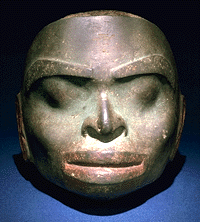
Tsimshian Mask
 |
Collected by Israel Wood Powell in 1879 at Kitkatla, British Columbia, according to his rather confused records, but more likely at Port Simpson or other northern community; soapstone, painted with red and green pigments; 24 x 22.5 x 18.2 cm. CMC VII-C-329 This stone mask has a twin residing in Paris in the Musée de l'Homme. Separated over one hundred years ago, the two masks were not reunited until 1975, when the Paris mask travelled to Canada to appear in an exhibition. It was then that the relationship between the two masks, expressions of the same face, was discovered. CMC's mask, without apertures for eyes, fits snugly over the Paris mask, with its round eyeholes. It is thought that the pair was worn in a naxnox performance, where an individual's personal power was displayed in dance. To present the illusion of the eyes actually opening and closing, the dancer must have turned quickly while removing the "blind" mask to reveal the one with eyeholes. The dancer would have needed considerable strength to hold the four-kilogram inner "sighted" mask in place with the wooden mouthpiece, although a harness attached through holes in the mask's rim might have helped support it. The "unsighted" mask may have been held in the hand, concealed by the dancer's costume. Since naxnox masks and other dance paraphernalia were kept hidden away when not in use, the audience would have thought that there was only one stone mask, and that it had the ability to open and close its eyes as some wooden transformation masks could do. William Duncan, the missionary who established Metlakatla, British Columbia, offered the sighted mask for sale in 1878, noting that it represented the "Thief". In Northwest Coast mythology, "Thief" refers to Raven, who is a culture hero of the Tsimshian. One of the Raven stories recounts how he stole the sun and then released it on the Nass River to illuminate what had been a totally dark world. The theatre of the mask may have emphasized the dramatic moment for humanity in the transition from unseeing to seeing. |
